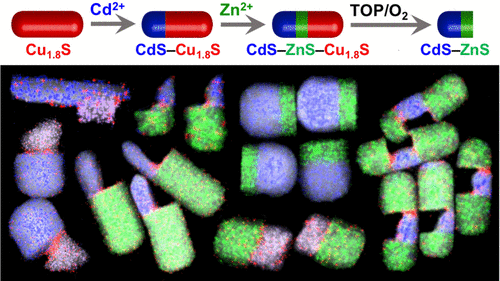当前位置:
X-MOL 学术
›
ACS Mater. Lett.
›
论文详情
Our official English website, www.x-mol.net, welcomes your
feedback! (Note: you will need to create a separate account there.)
Retrosynthetic Design of Morphologically Complex Metal Sulfide Nanoparticles Using Sequential Partial Cation Exchange and Chemical Etching
ACS Materials Letters ( IF 9.6 ) Pub Date : 2020-08-05 , DOI: 10.1021/acsmaterialslett.0c00287 Auston G. Butterfield , Benjamin C. Steimle , Raymond E. Schaak
ACS Materials Letters ( IF 9.6 ) Pub Date : 2020-08-05 , DOI: 10.1021/acsmaterialslett.0c00287 Auston G. Butterfield , Benjamin C. Steimle , Raymond E. Schaak

|
Designer nanoparticles with complex morphologies are of growing interest for a wide range of applications, but making them rationally and scalably remains challenging. Here, we demonstrate a retrosynthetic approach to access morphologically complex colloidal nanoparticles by combining partial sequential cation exchange reactions with chemical etching. Rational synthesis of the targeted nanoparticles containing ZnS, CdS, or CoS began by identifying heterostructured nanorod precursors that contained precisely located regions of Cu1.8S, which were subsequently etched with trioctylphosphine in the presence of oxygen to generate the desired product. Appropriate heterostructured nanorod precursors were then synthesized by replacing some of the Cu+ cations in colloidal Cu1.8S nanorods with Zn2+, Cd2+, or Co2+, using exchange sequences that were known to produce the desired features. The residual Cu1.8S was then dissolved, converting the Cu1.8S regions into void space. Mixed-population samples were also used to explore and identify a wider swath of potential retrosynthetic pathways and targeted morphologies, as well as morphological tunability. Collectively, several new classes of complex nanoparticles were synthesized, including nanoparticles having a flat end on one side and a faceted tip on the other, nanoparticles having a different material on the top and bottom, and nanoparticles having various protrusions and notches.
中文翻译:

形态学复杂的金属硫化物纳米粒子的逆合成设计使用顺序部分阳离子交换和化学蚀刻。
具有复杂形态的设计纳米颗粒在广泛的应用中越来越受关注,但是合理合理地制造它们仍然具有挑战性。在这里,我们演示了通过结合部分顺序阳离子交换反应与化学蚀刻来访问形态复杂的胶体纳米粒子的逆合成方法。包含ZnS,CdS或CoS的目标纳米粒子的合理合成始于确定异质结构的纳米棒前体,这些前体包含精确定位的Cu 1.8 S区域,随后在氧气存在下用三辛基膦进行蚀刻以生成所需的产物。然后通过置换胶体铜1.8中的某些铜+阳离子来合成适当的异质结构纳米棒前体使用已知可产生所需特征的交换序列,具有Zn 2 +,Cd 2+或Co 2+的S纳米棒。然后将残留的Cu 1.8 S溶解,将Cu 1.8 S区域转换为空隙空间。混合种群样本还用于探索和识别更广泛的潜在逆向合成途径和目标形态,以及形态可调性。集体地,合成了几种新型的复杂纳米颗粒,包括一侧具有平坦末端而另一侧具有刻面尖端的纳米颗粒,在顶部和底部具有不同材料的纳米颗粒以及具有各种突起和凹口的纳米颗粒。
更新日期:2020-09-08
中文翻译:

形态学复杂的金属硫化物纳米粒子的逆合成设计使用顺序部分阳离子交换和化学蚀刻。
具有复杂形态的设计纳米颗粒在广泛的应用中越来越受关注,但是合理合理地制造它们仍然具有挑战性。在这里,我们演示了通过结合部分顺序阳离子交换反应与化学蚀刻来访问形态复杂的胶体纳米粒子的逆合成方法。包含ZnS,CdS或CoS的目标纳米粒子的合理合成始于确定异质结构的纳米棒前体,这些前体包含精确定位的Cu 1.8 S区域,随后在氧气存在下用三辛基膦进行蚀刻以生成所需的产物。然后通过置换胶体铜1.8中的某些铜+阳离子来合成适当的异质结构纳米棒前体使用已知可产生所需特征的交换序列,具有Zn 2 +,Cd 2+或Co 2+的S纳米棒。然后将残留的Cu 1.8 S溶解,将Cu 1.8 S区域转换为空隙空间。混合种群样本还用于探索和识别更广泛的潜在逆向合成途径和目标形态,以及形态可调性。集体地,合成了几种新型的复杂纳米颗粒,包括一侧具有平坦末端而另一侧具有刻面尖端的纳米颗粒,在顶部和底部具有不同材料的纳米颗粒以及具有各种突起和凹口的纳米颗粒。











































 京公网安备 11010802027423号
京公网安备 11010802027423号